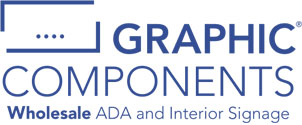In-Laid Applique ADA Signs
In-laid Appliqué signs are signs where copy is milled into a face plate with appliqué set down into the milling, leaving the appliqué left sticking out above the face to be the height needed for ADA compliancy. This type of sign is requested because of the durability and the close appearance to Acrylic with Appliqué signs.
Identification: In-laid signs can be identified by the similar appearance to signs with appliqué (the edges of the raised lettering will be the same color as the face of the raised lettering and acrylic will also be very smooth across the face plate of the sign) except the appliqué will be very difficult to pick off the sign.
Production: Acrylic is supplied in several varieties, such as clear, non-glare, white, black, and frosted. These would be CNC precision cut with characters/pictograms milled into the face. Apart from non-glare and the frosted varieties, these must be painted with a satin or matte paint to reduce the glare for ADA compliancy. The material can be painted/printed on the surface (front), or the subsurface (back).
Surface painting shows the true flat color and includes the edges being painted, but is more susceptible to scratching.
Subsurface is a more protective way of painting/printing, and looking through a non-glare or frosted acrylic can give a dimensional look, which many opaque materials cannot offer! However, the edges are not usually painted.
After being painted, an “Appliqué” will be cut to the desired copy or pictogram and dropped into the matching copy or pictogram milling on the face. The sign also goes through an engraving process, in which holes are drilled, and Braille “Raster Beads” are inserted. If the sign is surface painted, the beads are typically inserted before painting, and get painted the same color as the face plate. If the sign is subsurface painted/printed, the beads will be inserted after painting/printing, and will be clear to show the color beneath.
Advantages: In-laid signs are very durable with the copy being very difficult to remove from the face. They are great for school systems, correctional facilities, and any other area they may be subject to tampering. If you’re looking for durability, this is a great choice.
Disadvantages: The in-lay process is a lengthy process, which makes these signs both difficult to produce in a limited time frame, as well as making them a more costly interior solution. They also have less flexibility with fonts and will have rounded corners on raised copy because of the milling process. Our standard milling process uses a 1/16” bit, causing 1/32” radius corners. There is an additional option of using a 1/32” bit when requested (See Page 38 for more information).
Add-ons: UHB Tape for mounting, Holes Drilled/Countersunk for Mounting, Radius Corners, Beveled Edges, Accent Bars, Back Plates, Cubicle Hangers, Window Areas for Paper Inserts, Conference Sliders, Wood Laminates, Metal Laminates, Inserted in Frames, and many more!






